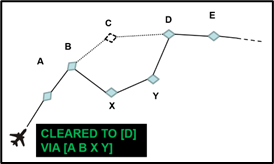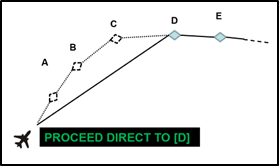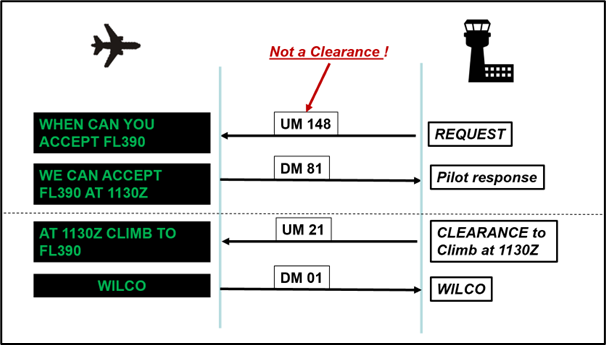CPDLC (Controller-pilot data link communications) allows flight crews and air traffic controllers to exchange non-urgent messages as an alternative to voice communications. Some CPDLC dialogues based on UM79 ‘CLEARED TO [position] VIA [routeClearance]’ and UM148 ‘WHEN CAN YOU ACCEPT FL[XXX]’ have been misinterpreted in EU airspace leading in some cases to incidents that have required controllers to intervene so that more serious negative safety impacts are avoided. This article will talk about the risk of misunderstanding UM79 and UM148 then explain how they should be interpreted.
In case you need any convincing, check out this fantastic video from Highbrow Safety Werks - Hello ATC!
UM79 - CLEARED TO [position] VIA [routeClearance]
There have been incidents after the air traffic controller (ATCO) sent the uplink message UM79 - CLEARED TO [position] VIA [routeClearance]’ to an aircraft. Flight crew have misinterpreted the end point [position] as DCT (DireCT route) and this confusion, mainly due to similarity between UM79 and UM74, has led to incidents. UM79 is typically used by ATC to ensure aircraft do not enter active military areas or ATC sectors where they are not expected.
It is important to clarify how UM79 ‘CLEARED TO [position] VIA [routeClearance]’ and UM74 ‘PROCEED DIRECT TO [position] should be understood by the flight crews.
In both UM79 CLEARED TO [D] VIA [A B X Y] and UM74 PROCEED DIRECT TO [D], the position [D] is already planned on the original route of the aircraft. UM79 always provides intermediate point(s) that are displayed on the same page as part of the full message or on another page in some aircraft HMIs (human machine interfaces). This may increase this confusion as only the position [D] may be displayed on the first page.
The pictures below provide examples of usage for UM79 and UM74.


UM148 ‘WHEN CAN YOU ACCEPT FL[XXX]’
Increasing number of incidents have occurred after the ATCO sent the CPDLC uplink message UM148 ‘WHEN CAN YOU ACCEPT FL[XXX]’ to an aircraft. The flight crews have misinterpreted this message as a clearance instead of a ‘request for the earliest time at which the specified level FL[XXX] can be accepted’.
Consequently, having received UM148, some flight crews have deviated from the approved flight level to the FL[XXX] indicated in UM148. If there is no subsequent action from the controllers, such an unauthorised manoeuvre may lead to loss of separation.
CPDLC uplink messages can be divided into 6 categories (Transfer of Communications, Level Changes, Instructions, Route Changes, Speed Changes, Heading Changes) and UM148 ‘WHEN CAN YOU ACCEPT FL[XXX]’ is clearly considered as an instruction that requires following pilot responses:
either WE CAN ACCEPT [level] AT [time] via CPDLC downlink message DM81,
or WE CANNOT ACCEPT [level] via CPDLC downlink message DM82.
ICAO PANS-ATM Doc.4444 makes a difference between an ATC clearance, defined as “an authorization for an aircraft to proceed under conditions specified by an ATC unit for expediting and separating air traffic” and an ATC instruction, defined as “a directive issued by ATC unit for the purpose of requiring a pilot to take a specific action”. Consequently, an instruction is not a clearance.
It is important to highlight that some avionics HMIs provide the capabilities to accept FL[XXX] referred in UM148 with the preformatted response "WE CAN ACCEPT [level] NOW", however, this case is not considered as a clearance either. A clearance must first be initiated by ATC.
Note: ATC clearances providing a ‘Level Change’ can be conveyed using a set of different CPDLC messages such as UM19 MAINTAIN [level], UM20 CLIMB TO [level], UM21 AT [time] CLIMB TO [level], UM23 DESCEND TO [level], UM26 CLIMB TO REACH [level] BY [time], UM27 CLIMB TO REACH [level] BY [position], UM28 DESCEND TO REACH [level] BY [time], etc.
The image below provides an example of usage for UM148.

Recommendations:
As flight crew you must be aware of how to interpret UM79 - CLEARED TO [position] VIA [routeClearance] and UM148 ‘WHEN CAN YOU ACCEPT FL[XXX]’. If you are a Safety Manager, share this information with your flight crews to help raise awareness.
Most particularly, the training programmes and subsequent training manuals should refer to the CPDLC dialogues supported by UM79 and UM148 and should highlight the risks of misunderstanding of these messages. Your flight manual should also refer to UM79 and UM148.
Please log in or sign up to comment.